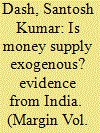|
|
|
Sort Order |
|
|
|
Items / Page
|
|
|
|
|
|
|
| Srl | Item |
| 1 |
ID:
122455


|
|
|
|
|
| Publication |
2013.
|
| Summary/Abstract |
Tourism is one of the largest and fastest growing industries in the world, which makes it a potential strategic factor for economic growth. This adds to the strong interest in the role of tourism in Malaysia's economic growth as it is the second-largest contributor to foreign exchange earnings after manufacturing. In addition, empirical results associated with Granger causality among economic growth, tourism and exports within the neoclassical framework are inconsistent. The objectives of this study, thus, are to determine: the long-run relationship; the long-run and short-run Granger causality; and the long-run triangular Granger causality between economic growth and tourism receipts corresponding to selected macroeconomic variables such as government tourism expenditure, physical capital, education, health and exports as control variables. The long-run Granger causality in vector error correction model (VECM) shows economic growth, tourism receipts and health complement each other (bidirectional causality), while unidirectional causalities are found between government tourism expenditure, physical capital, education and exports to economic growth. In addition, enhancing physical capital, education, health, exports and government tourism expenditure precede tourism receipts; all these in turn indirectly lead to economic growth, thus witnessing triangular relationships among them.
|
|
|
|
|
|
|
|
|
|
|
|
|
|
|
|
| 2 |
ID:
088276


|
|
|
|
|
| Publication |
2009.
|
| Summary/Abstract |
In this paper, the Johansen cointegration technique is used to examine the causal relationship between per capita energy consumption (PCEC) and per capita gross domestic product (PCGDP) for Tunisia during the 1971-2004 period. In order to test for Granger causality in the presence of cointegration among the variables, a vector error correction model (VECM) is used instead of a vector autoregressive (VAR) model. Our estimation results indicate that the PCGDP and PCEC for Tunisia are related by one cointegrating vector and that there is a long-run bi-directional causal relationship between the two series and a short-run unidirectional causality from energy to gross domestic product (GDP). The source of causation in the long-run is found to be the error-correction terms in both directions. Hence, an important policy implication resulting from this analysis is that energy can be considered as a limiting factor to GDP growth in Tunisia. Conclusions for Tunisia may also be relevant for a number of countries that have to go through a similar development path of increasing pressure on already scarce energy resources.
|
|
|
|
|
|
|
|
|
|
|
|
|
|
|
|
| 3 |
ID:
152763


|
|
|
|
|
| Summary/Abstract |
Against the backdrop of the claim that the rising growth rate of money is one of the major factors behind India’s recent bout of elevated and sticky inflation, this article asks: Is money supply exogenous or endogenous, and can it predict future inflation. This question is investigated using the monetarist framework of inflation. In the empirical analysis of data spanning from 1970–71 to 2009–10, the results of both the monetarist and the error-correction models suggest that money supply accounts for inflation in India. There is also the presence of an error-correction mechanism among money, inflation and output. However, a monetarist equation does not tell anything about causality. Thus, the vector autoregression (VAR) method is used to detect the direction of causality between money supply and the inflation rate. Findings from Granger causality tests suggest weak evidence of inflation (Granger) causing money supply. As a robustness check, we estimate VAR models using quarterly data and, further, using core inflation. The results of the causality tests from the quarterly data, the impulse response function and forecast error variance decomposition suggest that money supply is weakly endogenous.
|
|
|
|
|
|
|
|
|
|
|
|
|
|
|
|
|
|
|
|
|